In order to turn the garden into a lush jungle of vineyards, as well as to provide yourself, your family and friends with the delicious fruits of this vine, it is important to carefully understand all the subtleties of growing a culture. To do this, you need to know how to propagate grapes with cuttings in the fall, as well as carefully follow the rules of care and take into account the recommendations of professionals.
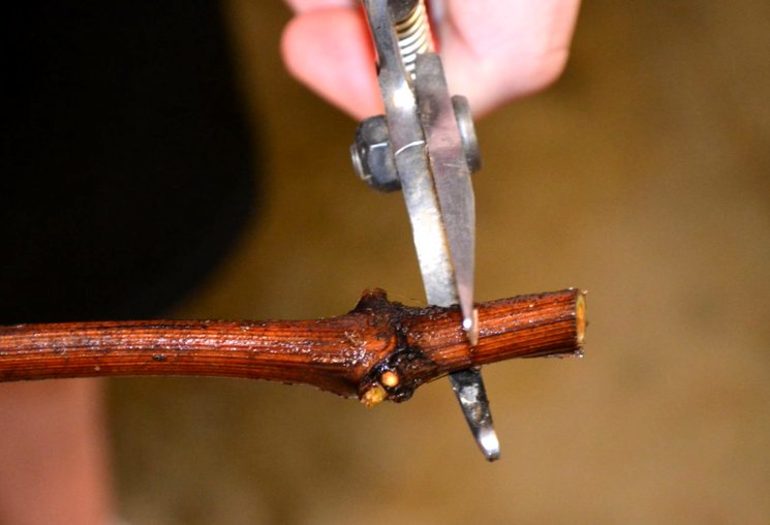
Content
Features of Cherenkovanie
Since ancient times propagation of grapes in the home garden or the vineyard was considered a kind of cult. People have always appreciated the amazing properties of the fruits of such a culture, creating on their basis delicious drinks, tinctures and other valuable products.
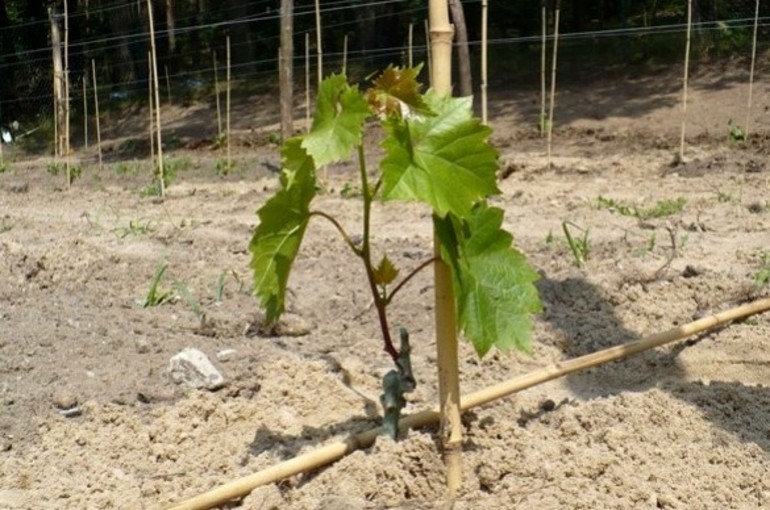
Engaged in the cultivation of vines at home, it is not enough to grow one bush. You will need to find a quality planting product and propagate the culture in order to enjoy a fresh crop annually. For this purpose, you can use several grown seedlings purchased at the hardware store, but their cost can be prohibitively high, and maintaining grading in this way is problematic. A more promising solution is the propagation of grapes by cuttings in the fall at home.
First of all, it is necessary to prepare suitable chubuki for planting in open ground. For beginning gardeners and winegrowers, such an event may seem too complicated, but it is not. The root system of the vine is characterized by special unpretentiousness, therefore, subject to the basic rules, it will begin to develop and give new sprouts on both green and ripened pieces of the plant. Today, two options for cutting are practiced:
- spring;
- autumn.
The second option is characterized by many advantages, since proper storage and rooting of cuttings will lead to the fact that in spring a formed plant can be planted directly in the open ground. Moreover, the probability that it will take root and begin to form green shoots is almost equal to 100%.
The subtleties of harvesting cuttings
In order for rooting of grape cuttings to be successful in the fall, it is important to treat the procedure correctly blanks for planting raw materials. It is recommended to carry out it no earlier than two weeks before the discharge of leaves and the emergence of stable frosts. When selecting cuttings, should be guided by such criteria:
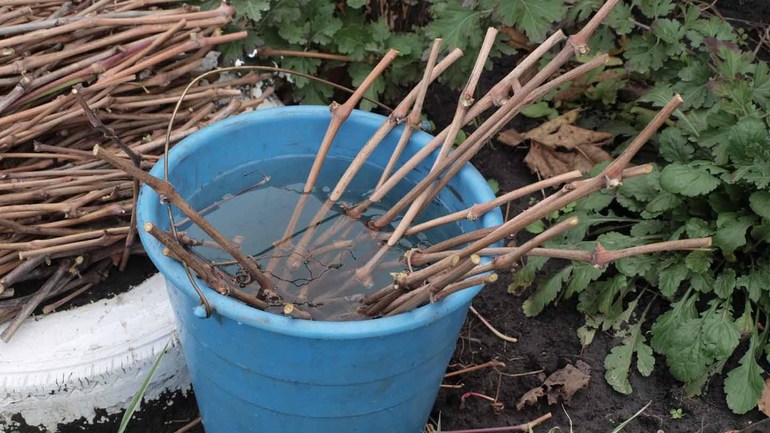
- A good planting material are chubuki with a thickness of up to six mm. Shoots with a larger diameter are fatty, unable to root.
- For reproduction to be successful, it is necessary to use only ripened and fruiting cuttings. It is important that they have good hardness and crackle slightly when bent.
- The surface of the handle should be light or dark brown. At the cut point, healthy planting stock has a green tint. If brown dots are visible, most likely it is sick or dead.
- Carrying out a visual inspection of the landing forelocks, you need to make sure that there are no mechanical damage, signs of illness, or other defects.
Having made a choice, it remains to start cutting, adhering to a length of 30 cm for each instance. In addition, it is important to make sure that 2–4 healthy eyes remain on each handle. When harvesting Chubuk, you need to be guided by a simple principle: the longer the selected option, the faster and better it will take root in the new conditions.
Winter storage rules
It is important for every gardener to know how to plant grapes with cuttings in the fall and what measures should be taken so that he can winter. Selected Chubuki should be stored at temperatures up to +4 degrees Celsius. At the same time, they must be thoroughly cleaned of the remains of foliage, mustache and stepsons, because they can start premature vegetative processes. Slices of vines are twisted with a soft gum or rope into a bunch, and then they are marked with a tag with the name of the variety.
There are different storage methods of cuttingsbut to the most relevant the following can be attributed:
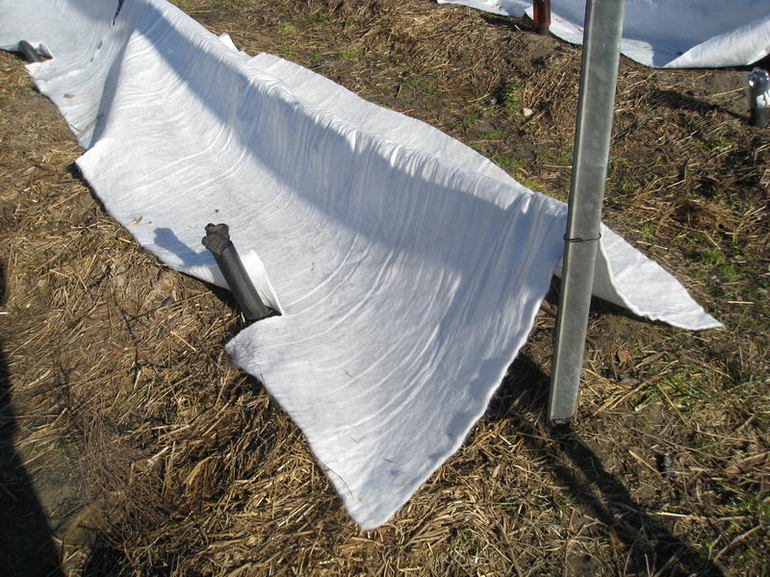
- The content of planting stock in the cellar or basement. For this, it is not necessary to equip specific conditions: it is enough to dig the cuttings in a vessel with sand and leave there until February days.
- Wintering cuttings in the garden involves the preliminary arrangement of the trench, a depth of about half a meter. The optimal length of such a recess is determined by the length of the cuttings. The bottom of the pit is lined with a sand layer 10 cm thick. Then, on top of the sand, ligaments of chubuk are laid out, which are sprinkled with the remaining soil, foliage or straw. The last, top layer is covered with plastic wrap.
- The optimum storage temperature of the cuttings is in the range of 3-6 degrees Celsius. Great environment for winter cropped shoots is the refrigerator door. In this case, you can not worry about a stable temperature regime. Before placing the cuttings in the refrigerator, they must be thoroughly soaked in cold water for two days, and then wrapped in polyethylene. The technique is useful in cases where the amount of planting material is not too large.
Effective rooting
For the reproduction of grapes in autumn to be successful, you need to be careful about providing optimal conditions for rooting. It is advisable to start the procedure in late January - early February. To do this, you will have to get the planting material from the storage place, and then treat it with a manganese solution. At the end of the treatment, the cuttings are additionally aged in the liquid for another 1-2 days.
Preparation for the procedure
Before rooting, the sections are further refreshed, and then two more fresh sections are made on each chubuk. When starting to cut grapes, you need to make sure that the inside of each copy is painted green, and at least 2 healthy eyes remain on the cuttings themselves. From the bottom of the chubuk using a thin blade or needle, you should make small indentations, and then treat them with “Kornevin”.
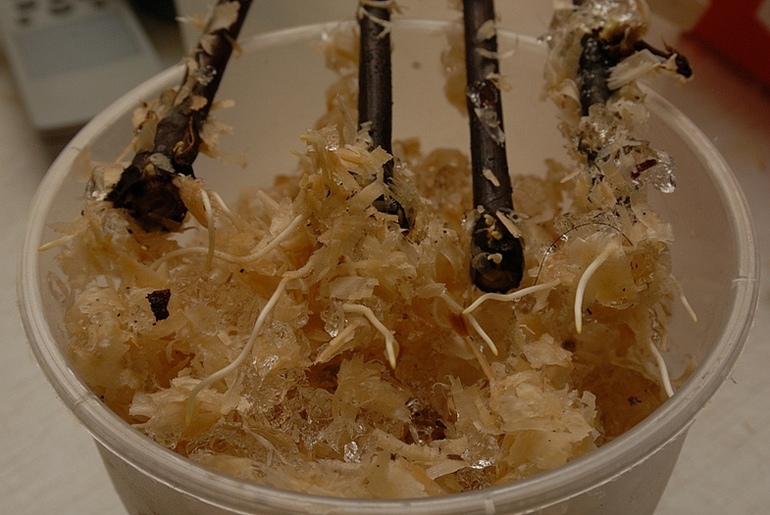
Among the available rooting methods, the most popular option is the use of sawdust. To realize it, you need to prepare a small container, and then place wet sawdust there. Bunches of cuttings are placed in the substrate, after which the capacity is transferred to the heating battery or any other heating unit. For successful rooting, sawdust needs to be moistened at least once every 5 days. In this case, after 19−21 days, the grape cuttings will let out small but viable roots.
Soil making
You can also consider the option of rooting the future vine in nutrient soil.Using this method, it is important to make sure that the earth has low acidity. To do this, it is diluted with components:
- light peat;
- sand;
- humus;
- fertile substrate.
The last part is poured into a plastic pot or a bottle cut into two. Holes for drainage are made in the bottom of the tank. The drainage layer itself should consist of pebbles, broken brick or expanded clay.
The method of rooting grapes in water is considered the least expensive. To successfully solve this problem, you need to pour a small amount of water into a glass container, and then place the planting material there. Successful rooting occurs with the formation of roots. If the first thing appeared green leaves - this indicates a certain malfunction in the growing season.
Landing
Successfully rooted planting material is planted in the soil somewhere in mid-April - early May. During this period of time, the first leaves and roots should appear on it. For a successful planting, you need to follow the instructions:
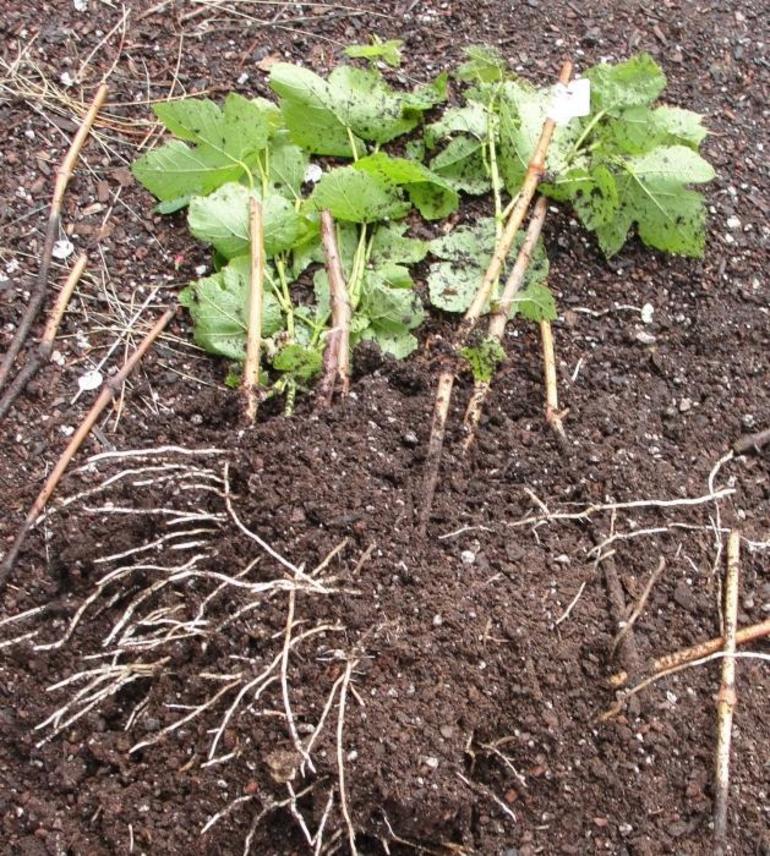
- First of all, you need to choose a promising place for placing cuttings in the ground. It should be light, warm and nutritious with good soil drainage.
- The selected area of soil is carefully dug up, and then diluted with humus, coarse sand and nitroammophos.
- Next, you should form a landing groove with the desired depth.
- Seedlings are placed in the soil so that the last eye is located 7-10 cm above ground level.
- The lower elements of the handle are sprinkled with soil, and then compacted.
- After successful planting of seedlings in the ground, they need to be carefully watered, and the soil should be treated with mulch.
Observing the basic rules for storing, rooting and moving planting material into the soil, it is possible to achieve high efficiency in growing grapes using cuttings. In this case, after a few months in the autumn, full seedlings with a good rhizome will form from the Chubuk.
Direct planting
The method of propagation of the vine through cuttings is laborious and painstaking. It involves the preliminary harvesting of suitable cuttings and their proper storage during the winter season. In addition, the gardener needs to spend a lot of time rooting the crop a few weeks before spring warming.
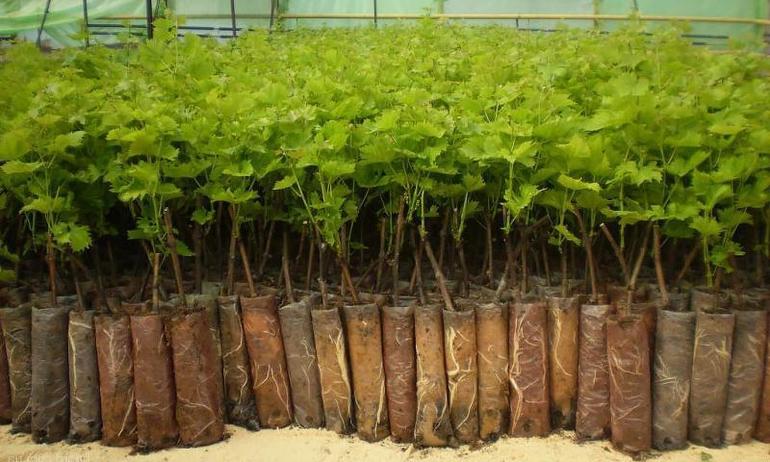
Naturally, the efforts spent are justified by a good yield and the yield of an impressive amount of healthy seedlings. But you can find a simpler solution, which is to land planting specimens directly in the soil. To carry out direct planting of cuttings in the ground, need to complete the activities:
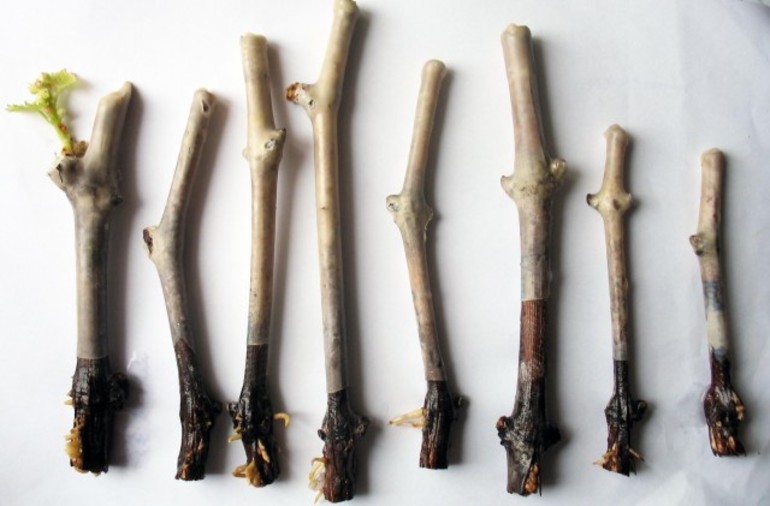
- Spend harvesting healthy planting specimensmake oblique sections on their tops.
- A stalk is placed in a suitable recess (optimal depth is 50-60 cm).
- When digging the cuttings with earth, you need to make sure that one eye is visible above the soil surface.
- Next, you need to dig in the planting material in fertile soil, compact it and pour over water. Before frost, cuttings are carefully watered.
- Just before winter grapes covered with spruce branches, straw, burlap or dry leaves.
- In early spring, the insulation layer is removed. It remains to wait for the formation of the first green leaves.
Such low rates force gardeners to apply a little trick: 2 cuttings are placed in each hole. In this case, the probability of engraftment will be higher. If two planting materials take root at once, the weak option will need to be removed.
Another simple option for growing grapes is to use layering. In any case, the propagation of vines using cuttings in the fall is the most relevant solution, which is characterized by a lot of advantages and features. Subject to the rules and following the instructions, the growing process will be productive, and the young vine will be prolific.




 Non-covering winter-hardy grape varieties for Moscow region
Non-covering winter-hardy grape varieties for Moscow region How to keep the vine in winter
How to keep the vine in winter When can I transfer grapes to another place in the fall
When can I transfer grapes to another place in the fall How to cover and prepare grapes for the winter in the suburbs
How to cover and prepare grapes for the winter in the suburbs